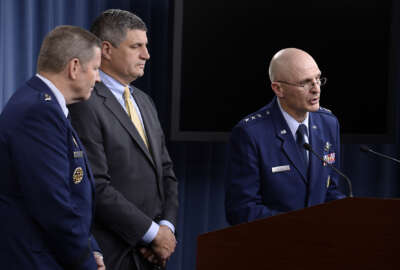
OTA contracts are the new cool thing in DoD acquisition
Other Transaction Authority contracts are gaining popularity in the Pentagon and military services.
Other transaction authority contracts seem to be the hip new thing in defense acquisition circles.
The Defense Department, the services and some of their components are all trying to jump on the OTA train as Congress continues to grant the military more authorities with the special contracts.
“This mechanism is just so much faster and so much more attuned to getting something quickly that we want today and not have to spend a couple years going through a protest, going through this huge process to get something we wanted two years ago,” Air Force Director of IT Acquisition Process Development Maj. Gen. Sarah Zabel said during an Oct. 19 speech at a Defense Daily event in Washington. “Everyone is very enthusiastic about OTAs. Still learning how to use them, still growing in the use, but they’re performing very well.”
For those unfamiliar, OTAs give DoD and the military services a work around for the traditional acquisition process. OTAs can take many forms, but are typically used to build prototypes of systems outside of the Federal Acquisition Regulations.
Prototype contracts can be up to $250 million and must use a nontraditional defense contractor, have all of its participants be small businesses or have at least a third of its total cost paid by parties other than the government.
Industry typically creates consortia around certain acquisition areas. Each consortium is built of businesses of all sizes who want to participate.
“As far as I can tell these consortia have hundreds of members that are industry, academia, others and it seems to be the fair market base. It’s the same folks you would be going out for a traditional contract [with],” Zabel said.
Zabel said the Air Force has a real interest in OTAs, especially in IT because of how quickly the contracts are awarded.
She said at some points the Air Force has held competitions where vendors bring in their ideas and are given a contract the same day.
That can be extremely beneficial to IT when the rate of change far outpaces the speed of the traditional acquisition process.
DoD isn’t turning a blind eye. Defense Undersecretary for Acquisition, Technology and Logistics Ellen Lord said last week that she wants OTAs to be one of ways the Pentagon cuts its contract delivery time by 50 percent in the future.
“Other transaction authorities, I think we see the Air Force doing a nice job with some of those and, frankly, we don’t have all of our staff that are totally cognizant of what those authorities are and what we can do and what we can’t do. What we are trying to do is develop an environment where people are comfortable saying ‘Hey, what if?’ and I’m trying to say ‘Yes, if’ versus ‘No’ to things,” Lord said.
The Air Force is trying to make it easier to use OTAs throughout the service by building off of its Rapid Capabilities Office.
As more acquisition programs move from the DoD’s acquisition office back to Air Force control, the service is taking the lessons it’s learned from the Rapid Capabilities Office and applying them more broadly, said Lt. Gen. Arnold Bunch, the military deputy for the Air Force assistant secretary for acquisition earlier this week.
RCOs in all of the branches have taken advantage of OTAs to deliver products quickly.
“We have taken the charter that the Rapid Capabilities Office was formed on. We have modified that charter. … What we are trying to do is inculcate that culture across the acquisition enterprise,” Bunch said. “We have morphed that charter so that we can apply it broadly across the Air Force.”
OTAs were pioneered in part by the Defense Innovation Unit Experimental (DIUx), an innovation hub created by former Defense Secretary Ash Carter to court nontraditional defense companies in Silicon Valley and other tech savvy cities.
DIUx used certain OTAs called Commercial Solutions Openings (CSO) that awards contracts in 60 days or less.
DIUx has awarded $100 million in funding for almost 50 programs. The organization has been able to obtain private investment to fund some programs. DIUx Director Raj Shah stated previously that it receives $3 in investments from customers for every $1 it invests.
Congress has been giving DoD the OTA authorities because it wants the Pentagon to be able to take more risks in acquisition and fail before it spends money building a whole program.
Experimentation “encourages innovative thinking, not just in developing the technology, but in how you use it. It helps ensure there is mature technology before you start production so that you don’t have those unexpected surprises. It reduces the odds that you are going to spend a lot of money on a program of record that you then have to cancel and have it all wasted,” House Armed Services Chairman Mac Thornberry (R-Texas) said in 2016.
Copyright © 2025 Federal News Network. All rights reserved. This website is not intended for users located within the European Economic Area.
Scott Maucione is a defense reporter for Federal News Network and reports on human capital, workforce and the Defense Department at-large.
Follow @smaucioneWFED





